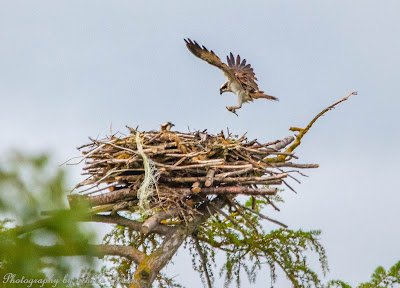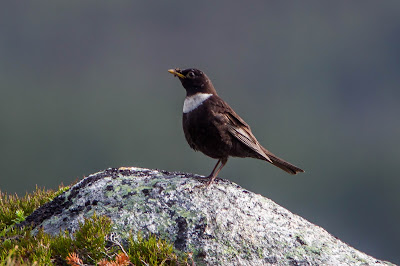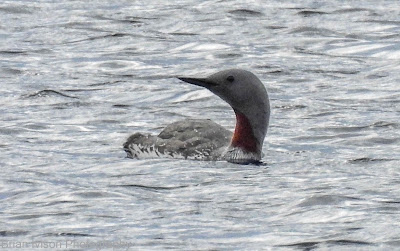July 2017 was fairly typical weather-wise for this area - generally warm, and a bit changeable, but as long as you had appropriate clothing to hand to deal with the variety of conditions, it was a very enjoyable and reasonably successful month for wildlife sightings, and although the days are shortening slightly now, this far north there are still around 18 hours of usable daylight.
Full-day safari bird species day lists dropped a little, down into the 40's, as some of our wader species moved away from their upland breeding territories to the coasts, and things have definitely quietened down , as just about every bird species seems to have successfully raised and fledged youngsters now.
Mammal day lists varied between 4 and 9, depending on the length of day, and variety of habitats visited...with early starts generally producing more and closer sightings, with again, many species seen with youngsters..
When the sun did shine, with the heather starting to turn a beautiful vivid purple, and the wild flowers and butterflies at their most abundant, the Cairngorms National Park really was a beautiful and unspoilt place to be, and my safari clients, from all around the world, including Canada, USA, Bahrain, Australia, Italy and Holland certainly seemed to enjoy themselves.....
 |
| The southern end of the Spey Valley |
To give you an idea of what you may realistically hope to see if you are planning a future July visit, I hope the following more detailed information, illustrated with photos taken at sites in and around the Cairngorms National Park by myself, my friends or my safari clients, will help....clicking on the picture enlarges it to full-screen.
Wildlife highlights included:
Local speciality and upland bird species seen regularly throughout the month included: Osprey, Red Grouse, Slavonian Grebe, Red-Throated Diver, Black-Throated Diver, Crested Tit, Ring Ouzel, Goldeneye and Dipper.
We also enjoyed some regular good views of Red Kite, a few decent sightings of Golden Eagle, and a couple of fleeting glimpses of Scottish Crossbill, though sadly Capercaillie and Black Grouse (not unusually) were not seen at all this month....
A day-trip up to Handa Island early in the month also produced great views of Auk colonies, Skuas and Terns...
Mammals seen regularly locally during the month included: Red Squirrel, Rabbit, Brown Hare, Roe Deer, Red Deer, Reindeer, Mountain Goat, and Bank Vole, with just a couple of sightings of Sika Deer, Mountain Hare and Stoat, and one brief glimpse of a Weasel....
A coastal excursion to Handa Island early in the month on one of the warm and sunny days provided great views of Seals ....
 |
| Osprey with fish |
Our local
Ospreys stole the show again this month, often being voted as 'Bird of the day' by my safari clients, with the adult birds seen fishing, delivering fish, and encouraging the fast growing 'scaly' looking , orange-eyed youngsters to take their 'maiden flights', and by late-month they had indeed fledged and were seen perched and flying for the first time.. I can therefore highly recommend July as THE month for
Osprey watching and photography in this area...
 |
| A skulking Red Grouse... maybe he knows the 'Glorious 12th' is looming... |
Red Grouse too
are always popular with my safari parties, as being a bird of uninhabited upland moors, most of my clients do not have them close to home. We, however, are fortunate to have lots of suitable heather moorland in this area, and throughout the month we enjoyed good close up views of families of up to 9 of these very characterful and beautifully marked birds, though with the 'glorious 12th' rapidly approaching... I suspect they may not be quite so obliging next month...
 |
| Slavonian Grebe by Byron Taylor |
Slavonian (Horned) Grebe, one of our rarest and surely one of our most beautiful British breeding birds, with the UK being at the very western limits of it's breeding range , have often struggled to breed successfully in this area in recent years, and sadly, it was bad news for our one 'local' pair this year, with the nest seemingly being predated early in the month, and the adults deserting the site, making a trip slightly 'out of area' to RSPB Loch Ruthven necessary to have a chance of seeing them...
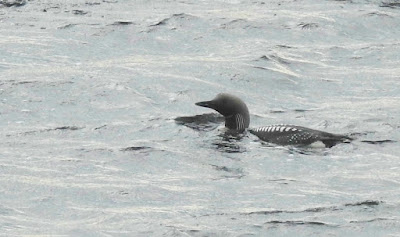 |
| Black-Throated Diver |
Divers (Loons) in their dapper summer plumage are always popular with my safari clients, and we were fortunate enough to get lots of good views of both Red-Throated and Black-Throated , though sadly, none with youngsters.... on their favoured local lochs throughout the month. It should be noted however, that they are rarely seen close to the shore, can be difficult to find in 'choppy' conditions, and are easily disturbed by non wildlife-friendly tourists dog-walking, swimming and boating etc, so the less windy days and early morning starts in search of them usually gave us our closest sightings....
 |
| Crested Tit by Colin Mount |
Crested Tits were seen reasonably frequently on our walks through Caledonian pine forests, often in family parties, though I must stress again, that knowing their distinctive rippling trills is a huge advantage in helping you to see these very 'flitty' little local specialities....
 |
| Crossbills |
It was a similar story with
Crossbills too, with the majority of our sightings being of the rather frustrating 'fly-over' variety, with them only being identified by their characteristic 'jip' 'jip' calls as they travelled between different parts of the forests...but we did get lucky on a couple of occasions, when they perched briefly, allowing views through a scope and the odd photo opportunity...
 |
| Ring Ouzel by Sheila Ivison |
Ring Ouzels continued
to show
well in upland habitats near their nesting and feeding areas, at least early in the month, but became noticeably more elusive as the month progressed as they and their recently-fledged young began to roam further afield, and it appeared that they may well have vacated this area and headed south for warmer climes by the end of the month....
 |
| Goldeneye family |
Goldeneyes only breed in the UK in northern Scotland, and their numbers have increased greatly in recent years, mainly due to the RSPB providing nest boxes on trees around most local lochs, and we got to see many large families of these very attractive little ducks this month...
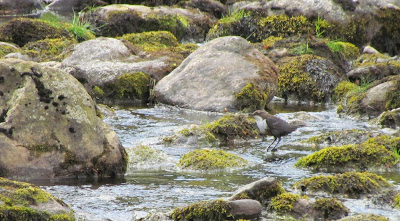 |
| Dipper |
Dipper sightings were a little bit hit and miss this month, with the birds seemingly quite mobile up and down the rivers, on some days we saw none, and on other days we saw one or more on each river we visited! Which just goes to show that sometimes you need a bit of luck......
Golden Eagle is probably hardest to see in mid-summer (in this area at least), as the birds have so many hours of daylight in which to hunt, but we did manage a few decent though usually distant views of birds hunting along ridges....
Still on raptors, we also saw
Peregrine,
Red Kite,
Common Buzzard,
Kestrel and
Sparrowhawk regularly during the month...
 |
| Snow Bunting |
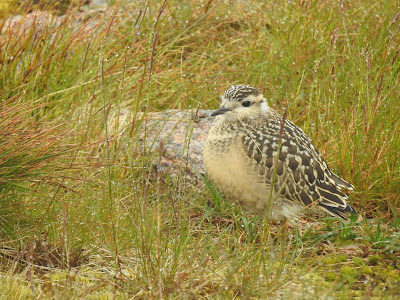 |
| Young Dotterel |
July is 'last chance saloon' for seeing all 3 of our mountain top species in one trip, as the
Dotterel often depart in early August..and although days of suitable weather (dry, calm and clear) were at a premium...we did get a couple of opportunities to take to the hills to see them , using my Cairngorm Mountain Birdwatching Guide qualification to allow us to use the funicular railway and then exit the (usually) closed system for a walk up to the summit,
Dotterel and
Snow Bunting , rather unusually, proved to be less difficult, though still not easy, to see than the
Ptarmigan, which were a bit elusive.....
 |
| Arctic Skua |
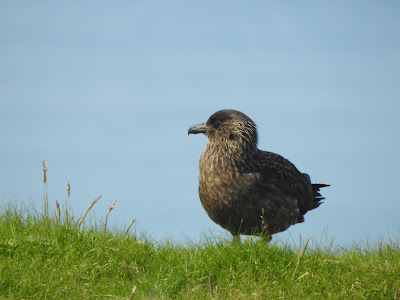 |
| Great Skua or 'Bonxie' |
 |
| Puffin |
June and July are the best months in which to visit a coastal seabird colony, so taking advantage of a favourable weather forecast, the 5th saw us take a very scenic drive up to the north-west coast to the SWT's wonderfully remote and beautiful
Handa Island.
Twite were seen feeding around Tarbet harbour car park, and even the short ferry crossing gave us super close-up views of
Seals, and
Black Guillemot , and once on the island, after our welcome talk by the SWT wardens, we went on to see
Red-Throated Divers, Snipe,
Wheatears,
Skylarks, and
Arctic and
Great Skuas galore nesting on the moors. Once at the impressively high cliffs and coastal stacks, we were treated to the unique sights, sounds (and smells!) of good numbers of
Gannets, Fulmars,
Kittiwakes,
Razorbills,
Guillemots (including the 'bridled' variety), and yes, everybody's favourite -
Puffins!
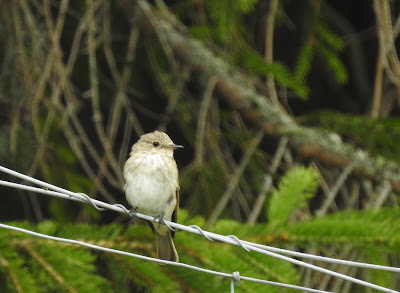 |
| Spotted Flycatcher |
Other good birds of note seen locally (in the early part of) this month included Cuckoo, Golden Plover, Redstart, Spotted Flycatcher, Pied Flycatcher and Wood Warbler, all of which can now be tricky to see in large parts of the UK....
We also had a couple of sightings of a couple of real 'rarities' in the form of 3 'fly-over'
Common Cranes on the 14th and a skulking
Blyth's Reed Warbler on the 3rd of the month, that I heard, but sadly, never saw.....
Onto mammals now....
The award for 'mammal of the day' as voted for by my safari clients, frquently went to that ever popular pine cone chomping, peanut-munching forest dweller, the cute and charismatic
Red Squirrel, who can usually be relied upon to appear for an easy feast at my favourite forest feeding stations.....though we also had a few 'random' sightings whilst on forest walks....often being alerted to their presence by the sound of falling pine cones....
 |
| Red Deer stags |
Red Deer were regularly seen in local upland glens, usually in large same-sex herds, the stags happily feeding and seemingly relaxing, and the hinds with their fast-growing young always nearby ....with many of my safari guests from far-away lands putting these iconic beasts high up on their 'wish-lists'....
 |
| Feral Mountain Goats |
In the same upland glens, we also had regular good views of large groups of another scarce and very localised mammal, the feral
Mountain Goat.. interesting animals, that come in a wide variety of colours, from white, through grey and brown to black, or sometimes a mixture of all of these...
Mountain Hares are definitely at their 'most difficult to see' time of year now...their mottled brown and grey coats providing near-perfect camouflage among the rocks in their mountainside homes...and so it proved ... with our sightings being limited to only a couple of distant glimpses..
 |
| Brown Hare |
Brown Hares however, proved to be much more obliging, especially early in the morning, with slow drives through quiet farmland, using my vehicle as a mobile hide giving us some decent views....
 |
| Dark Green Fritillary |
Butterflies at last began to feature, on the few still, warm and sunny days at least!, with the more common species now being joined by our 'local speciality' the
Scotch Argus towards the end of the month...though a decent photo has escaped me so far....
So my 'sum-up' for this month is quite similar to last month really, although the bird breeding season is almost over, July is a pretty decent month to see a good selection of birds, animals and butterflies in this area,
with no need for a really early start, and it's also good for a mountain-top adventure, or a trip to a seabird colony with (usually) fairly good weather, and all still with plenty of daylight hours....Though I must confess that I always tend to feel just a little sad at the end of every July , as I know that many of our summer visiting birds are soon to vacate our area and fly south to warmer climes as summer turns to early autumn next month.....
If you think you know someone who may enjoy a taste of what I do, why not treat them to a safari gift certificate. They make a thoughtful and imaginative present and are available for any amount in multiples of £10, and are valid at any time within a year from date of purchase....
 |
| The upper reaches of the River Spey |










